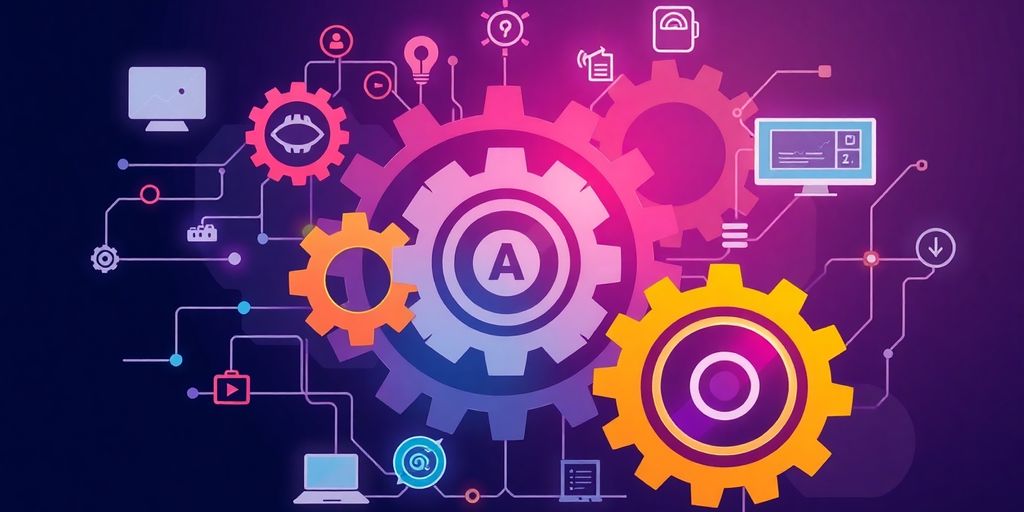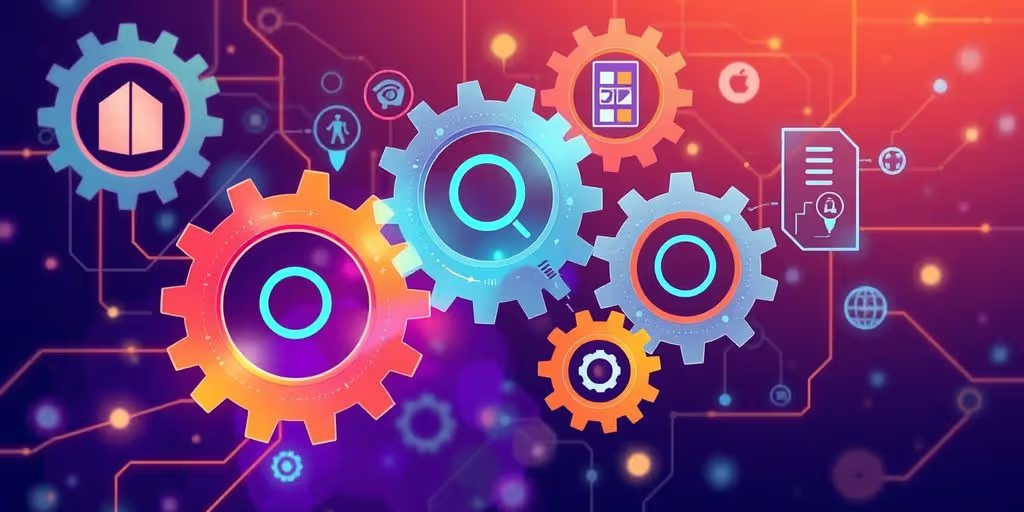"Automation Integration: Connecting Your Business Tools with AI-Powered Workflows"
Explore how artificial intelligence enhances business automation through AI-powered workflows and integration.
In today's fast-paced business landscape, companies are increasingly turning to artificial intelligence to streamline their operations. Automation integration, powered by AI, can connect various business tools and create efficient workflows. This article explores how businesses can leverage AI to enhance their automation processes, the components that make up AI-powered workflows, and the challenges they might face along the way.
Key Takeaways
- Artificial intelligence can significantly improve efficiency in business processes.
- Integrating AI with existing systems requires careful planning and the right tools.
- Data management is crucial for effective AI implementation in workflows.
- Businesses must be aware of data privacy and security when using AI.
- The future of AI in automation includes more autonomous systems and smarter decision-making.
Understanding Artificial Intelligence in Business Automation

Defining Artificial Intelligence
Okay, so what is AI, really? It's more than just robots taking over the world (at least for now!). At its core, AI is about creating computer systems that can perform tasks that usually need human intelligence. Think learning, problem-solving, and decision-making. It's about machines mimicking our cognitive abilities. There are different types of AI, from narrow AI, which is designed for specific tasks, to general AI, which aims to have human-level intelligence across the board. For business automation, we're mostly talking about narrow AI, which is already making a big impact. For example, AI can be used in business process automation to streamline operations.
The Role of AI in Automation
AI is changing the automation game. Traditional automation relies on pre-programmed rules, which can be rigid and inflexible. AI, on the other hand, brings adaptability and learning to the table. This means automation systems can now handle more complex and variable tasks. Instead of just following instructions, AI-powered systems can analyze data, identify patterns, and make decisions on their own. This opens up a whole new world of possibilities for automating processes that were previously too difficult or time-consuming. Consider these points:
- AI can automate tasks that require judgment and problem-solving.
- It can personalize customer experiences through data analysis.
- AI can optimize processes in real-time based on changing conditions.
Benefits of AI Integration
Why bother integrating AI into your business automation? Well, the benefits are pretty compelling. For starters, you can expect a significant boost in efficiency. AI can handle repetitive tasks faster and more accurately than humans, freeing up your employees to focus on more strategic work. Plus, AI can improve decision-making by providing data-driven insights. This can lead to better outcomes and a competitive edge. And let's not forget about cost savings. By automating processes and reducing errors, AI can help you cut expenses and improve your bottom line.
Integrating AI isn't just about automating tasks; it's about transforming how your business operates. It's about creating smarter, more efficient, and more responsive processes that can drive growth and innovation.
Key Components of AI-Powered Workflows
So, you're thinking about adding some AI magic to your business processes? Awesome! But before you jump in, it's good to know what makes these AI-powered workflows actually tick. It's not just about slapping some code together; there are a few key ingredients you need to get right.
Data Management and AI
Okay, let's be real: AI loves data. It's like the fuel that keeps the whole engine running. Without good data management, your AI is basically stumbling around in the dark. Think of it this way:
- Data Collection: You need to grab the right data from all over the place. Sales figures, customer feedback, website clicks – the more, the merrier (as long as it's relevant!).
- Data Cleaning: This is where you get rid of the junk. Typos, duplicates, missing info – gotta clean it all up so the AI doesn't get confused.
- Data Storage: Where are you gonna put all this stuff? A fancy cloud database? An old server in the closet? Choose wisely.
Proper data management isn't just about storing information; it's about making sure that information is accessible, reliable, and ready for your AI to use. If your data is a mess, your AI will be too.
Machine Learning Algorithms
Alright, now for the brains of the operation: machine learning. These algorithms are what let the AI learn from your data and make smart decisions. There are tons of different types, and picking the right one is key. Here's a quick rundown:
- Supervised Learning: You teach the AI by showing it examples. Like, "This is a picture of a cat," and "This is not a picture of a cat." Eventually, it learns to tell the difference on its own.
- Unsupervised Learning: You just dump a bunch of data on the AI and let it find patterns. Great for discovering hidden trends you never knew existed.
- Reinforcement Learning: The AI learns by trial and error, like a video game. It gets rewards for doing the right thing and penalties for messing up.
Natural Language Processing
Ever talked to a chatbot that actually understood what you were saying? That's the magic of Natural Language Processing (NLP). It lets AI understand and respond to human language. This is super useful for things like:
- Customer Service: Chatbots that can answer questions and solve problems.
- Sentiment Analysis: Figuring out if people are happy or angry based on their social media posts.
- Content Creation: AI that can write articles, emails, and even poetry (if you're into that sort of thing).
NLP is getting better all the time, and it's making AI interactions feel way more natural. It's not perfect, but it's getting there. And that's what makes AI-powered workflows so powerful – they can actually understand what's going on and respond accordingly.
Implementing AI Solutions in Your Business
Identifying Automation Opportunities
Okay, so you're thinking about bringing AI into your business. Cool! First things first, you gotta figure out where it'll actually make a difference. Don't just throw AI at every problem; that's a recipe for wasted money and frustration. Look for those repetitive, time-consuming tasks that are just begging to be automated. Think about things like:
- Data entry
- Customer service inquiries
- Report generation
The goal is to free up your human employees to focus on stuff that requires actual human intelligence and creativity. If you can pinpoint those areas, you're already halfway there.
Choosing the Right AI Tools
Alright, you know what you want to automate. Now comes the fun part: picking the right tools. There are a zillion AI solutions out there, and it can be overwhelming. Do your homework! Don't just go with the flashiest product or the one with the best marketing. Consider these things:
- Compatibility: Does it play nice with your existing systems?
- Scalability: Can it grow with your business?
- Cost: Can you actually afford it, not just initially, but long-term?
It's better to start small with a tool that fits your needs and budget than to overspend on something that's too complex or doesn't integrate well.
Integrating AI with Existing Systems
So, you've got your AI tool. Awesome! Now, the real challenge: getting it to work with everything else. This is where things can get tricky. You'll probably need some technical expertise, either in-house or from a consultant. Make sure your data is clean and properly formatted, and that your systems can communicate with each other. This might involve some custom coding or API integrations. It's not always a walk in the park, but it's crucial for making your AI implementation a success. Think of it like building with Lego bricks – you need to make sure all the pieces fit together properly to create something awesome.
Challenges in AI Integration
Okay, so you're thinking about bringing AI into your business. Awesome! But let's be real, it's not all sunshine and rainbows. There are definitely some bumps in the road you need to watch out for. It's like when I tried to bake a cake from scratch – looked easy on TV, but the reality was a flour-covered kitchen and a cake that resembled a hockey puck. AI integration can be similar if you're not prepared.
Data Privacy and Security Concerns
Data, data, data. AI loves data, but that's also where a lot of the headaches come in. You've got to think seriously about data privacy and security. Are you handling customer data responsibly? Are you complying with regulations like GDPR or CCPA? A data breach can be a total nightmare, not just for your reputation but also for your wallet. Make sure you have robust security measures in place, and that you're transparent with your customers about how you're using their data. It's not just about avoiding fines; it's about building trust.
Managing Change in the Workforce
Let's face it, some people get nervous when they hear the words "artificial intelligence." They might worry that AI is going to take their jobs. It's important to address these concerns head-on. Instead of framing AI as a job replacement, emphasize how it can augment human capabilities. Offer training programs to help employees adapt to new roles and responsibilities. Open communication is key. Explain how AI can make their jobs easier and more fulfilling, not obsolete. It's about AI agents working with people, not replacing them.
Technical Limitations of AI
AI is powerful, but it's not magic. It has limitations. Sometimes, AI models can be biased, leading to unfair or discriminatory outcomes. Other times, they can be brittle, failing spectacularly when faced with unexpected inputs. And let's not forget the "black box" problem – it can be hard to understand why an AI made a particular decision. It's important to be aware of these limitations and to have strategies for mitigating them. This might involve using multiple AI models, incorporating human oversight, or focusing on tasks where AI is less likely to make mistakes.
It's easy to get caught up in the hype around AI, but it's important to remember that it's just a tool. Like any tool, it has its strengths and weaknesses. The key to successful AI integration is to understand these limitations and to use AI in a way that complements human capabilities.
Future Trends in AI and Automation

As AI tools get smarter, they’ll start doing more than just offering suggestions. Machines will think ahead and take action with less help from people. It's a shift you can see in labs and in factories already.
The Rise of Autonomous Systems
The shift toward autonomous machines is gaining pace. In the next few years, robots, drones, and vehicles will move around without waiting for a human signal. Here’s how some fields stack up:
Many sectors are already on board:
- Transportation fleets testing self-driving trucks
- Warehouses using picking robots
- Farms running drone surveys
- Mines tracking driverless haul trucks
AI in Decision-Making Processes
AI isn’t just for routine tasks. It’s stepping into boardrooms and trading floors to sort data and tip the balance in tight calls. Many firms now trust AI for tasks such as automated investing, portfolio checks, and risk scoring. Common perks include:
- Faster data scans that spot trends in minutes.
- Real-time alerts when numbers drift off target.
- Scenario runs to see what might happen next.
Impact of AI on Job Markets
From routine gigs to creative jobs, the work scene will shift again. Some roles will fade, while new ones pop up around AI upkeep and oversight. By 2030, some routine roles might vanish or change beyond recognition.
Workers will need to pick up new skills as machines take on more of the dull and repeat tasks.
So it's not all doom and gloom. Folks who adapt will find fresh angles. And that’s where the real story is.
Case Studies of Successful AI Integration
Retail Industry Innovations
Okay, so let's talk about retail. I was reading about this one company, and it's pretty cool. They use AI to predict what customers are going to buy. It's not just guessing; they look at past purchases, what's trending on social media, and even the weather. This helps them stock the right items and offer personalized deals.
- Improved inventory management
- Personalized customer experience
- Increased sales conversion rates
It's like they know what you want before you do. They've seen a significant increase in sales and customer satisfaction. It's a win-win.
Healthcare Automation Examples
Healthcare is another area where AI is making a big difference. Think about diagnosing diseases. AI algorithms can analyze medical images, like X-rays and MRIs, to spot things that doctors might miss. It's not about replacing doctors, but giving them a powerful tool to make better decisions. One hospital used AI to predict patient readmissions, and they managed to reduce them by a lot.
Here's a quick look at some benefits:
Manufacturing Efficiency Gains
Manufacturing is getting a serious upgrade with AI. Companies are using AI to monitor their equipment and predict when it needs maintenance. This means less downtime and more efficient production.
Here's how it works:
- Sensors collect data from machines.
- AI algorithms analyze the data to identify patterns.
- Maintenance is scheduled before breakdowns occur.
It's all about keeping things running smoothly and avoiding costly interruptions. It's pretty amazing how much more efficient things can be when you add a little AI to the mix.
Best Practices for AI Workflow Optimization
Continuous Learning and Improvement
AI systems aren't a 'set it and forget it' kind of deal. They need constant attention and tweaking. Think of it like tending a garden; you can't just plant seeds and walk away. You need to regularly check in, see what's growing well, and pull out the weeds. With AI, this means constantly feeding it new data, refining the algorithms, and making sure it's still aligned with your business goals. It's also about staying updated on the latest advancements in AI. The field is moving so fast that what was cutting-edge last year might be outdated now.
Monitoring AI Performance
Keeping an eye on how your AI is doing is super important. You need to know if it's actually helping or just creating more problems. This means setting up some key performance indicators (KPIs) and tracking them closely. Are you seeing an increase in efficiency? Are customers happier? Is the AI making accurate predictions? If the answer to any of these questions is 'no,' then it's time to dig deeper and figure out what's going wrong. Maybe the data is bad, or the algorithm needs adjusting. Whatever it is, you won't know unless you're actively monitoring the AI's performance. You can optimize workflows by monitoring AI performance.
User Training and Support
Okay, so you've got this fancy AI system up and running, but what about the people who are supposed to use it? If your employees don't know how to work with the AI, it's not going to do you much good. That's why user training is so important. You need to teach your team how to interact with the AI, how to interpret its outputs, and how to handle any issues that might arise. And it's not just a one-time thing. As the AI evolves, so should the training. Plus, you need to provide ongoing support so that users can get help when they need it.
Think of it this way: you wouldn't give someone a race car without teaching them how to drive, right? Same goes for AI. Give your users the tools and knowledge they need to succeed, and they'll be much more likely to embrace the technology and use it effectively.
Here's a simple example of how training can impact AI adoption:
Final Thoughts on Automation Integration
In wrapping things up, integrating automation with AI can really change the game for businesses. It’s not just about making things faster; it’s about making them smarter. By connecting your tools, you can streamline processes and reduce the hassle of repetitive tasks. Sure, it might take some time to set everything up, but once you do, the benefits are huge. You’ll save time, cut costs, and maybe even boost your team’s morale since they can focus on more interesting work. So, if you haven’t started yet, now’s the time to think about how automation can work for you. It’s a step toward a more efficient future.
Frequently Asked Questions
What is artificial intelligence (AI)?
Artificial Intelligence, or AI, is a type of technology that allows machines to think and learn like humans. It helps computers perform tasks that usually require human intelligence, such as understanding language or recognizing patterns.
How does AI improve business automation?
AI enhances business automation by making processes faster and more efficient. It can handle repetitive tasks, analyze large amounts of data, and make predictions, which helps businesses save time and reduce mistakes.
What are some common AI tools for businesses?
There are many AI tools available for businesses, including chatbots for customer service, data analysis software, and tools for automating marketing tasks. These tools help companies work smarter and improve their services.
What challenges do businesses face when integrating AI?
Businesses may face challenges like data privacy issues, the need for employee training, and potential technical problems when integrating AI. It's important to plan carefully to overcome these obstacles.
How can businesses ensure their AI systems are secure?
To keep AI systems secure, businesses should use strong security measures, regularly update their software, and train employees on best practices for data protection.
What is the future of AI in the workplace?
The future of AI in the workplace looks promising. It is expected to automate more tasks, assist in decision-making, and even create new job opportunities as technology continues to evolve.








